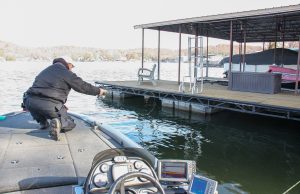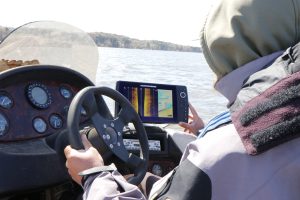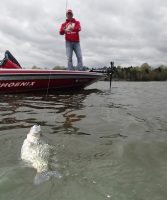Dan Dannenmueller is working trees along an old fence row. Factors for picking
the best side to fish might include light penetration, side with deepest water, current,
wind direction, and sun direction. Choosing correctly determines success or failure.
(Photo: Tim Huffman)
Choosing Sides
Photos and Story by Tim Huffman
In two separate instances recorded in the Bible, Jesus told his disciples to “cast your nets on the other side,” leading to miraculous catches of fish.
“Sides” are indeed, critical to success for many fishermen. Which side of the lake or river to fish, which side of the log, brushpile or dock to cast your lure or as Jesus suggested, which side of the boat to fish out of.

I attended a tournament years ago at Truman Lake when, on the last day of the tournament, the team of Ronnie Capps and Steve Coleman faced a fierce current from flood waters. The current sent fishermen running, but Capps and Coleman stayed in their stumpy fishing spot to win the tournament.
Their secret?
The current was so strong that one person simply controlled the boat while the other angler fished trees and stumps, putting the bait on the backside of the stumps where the current was minimal. The situation was difficult, but they created a way to catch fish and win the tournament, by fishing only the correct side of the stumps and trees.
This article, “Choosing Sides” is a quick look at various situations, sides and edges. Paying attention to these factors can make the difference between catching fish or getting skunked.
Which Side of the Lake
“In early spring I’m going to the W/NW side of the lake,” said Dan Dannemueller, tournament fisherman and publisher of CrappieNOW. “Prevailing winds are cold NW winds so the NW side of the lake will be most protected. Plus, the water will be warmer because of the prevailing sun that time of year. In mid-spring I want to go to the side with the most good spawning areas.”
Dannenmueller says summer is a time to hit channel bends in deeper water. The best channel side is the one the sun is on so the ledge will be providing shade for the crappie. It’s the east ledge in the morning and west ledge in the afternoon. Crappie will be in the shade or deeper water.
“Fall is a time for crappie to be chasing shad and actively feeding,” said Dannenmueller. “Wind current is common in the fall transition, so NW winds will bring colder water and current pushing into the S/SE side of the lake. Bass like that but crappie do not. Most of the shad and crappie will move to the calmer side of the lake. As water cools, shad will go up into the creeks by the millions. You have to search to find the N/NW side of the creeks and coves with shad.”

Dannenmueller says winter fish move toward spawning areas but into the deepest water available. Again, the N/NW sides are usually best, but water temperature and current are big factors for fish location.
Docks & Shade
Wally Marshall, promoter and a national tournament champ, is a dock-fishing expert. He says, “I start by using my electronics to find docks where a channel comes in close to the bank. Fish like to be near a channel. I’ll scan those docks with side imaging to see if fish are there. I’m also looking at the shade and cover. I prefer floating docks because they are closer to the water and create more shade than piers because the pier docks are higher off the water.
“I like to shoot with a 7-foot rod, using 6-pound test and a 1/32-ounce jig. I like mono because it has stretch so it tears fewer lips.”
Fish depth around docks will vary, but don’t be surprised if most of the fish are one- to three-feet deep under docks and pontoons. It doesn’t matter if water is 8 feet or 40 feet, crappie will likely be shallow. Also, they will be in the darkest shade, often as far back as you can shoot along a walkway or under a pontoon. Side imaging is a good way to scan large numbers of docks. However, if you have forward-facing sonar, it takes all guesswork out of finding the exact locations and depth of fish.
Lily Pads & Shade
Louie Mansfield, Grizzly Jig Company owner, says there are areas with sun or shade, so fish the shady sides. “Summer water gets hot in Reelfoot Lake because it is a shallow lake. Lily pads can be difficult to fish but can hold some good fish. Shade is critical. I recommend looking in three to five feet of water, sometimes shallower. It’s best to jig fish, using nothing shorter than a 12-foot pole, the longer the better. Work your bait next to the biggest pads you can find and fish from the top of the water down to the bottom. Fish may be shallow under the pad or next to the bottom, but shade is the key.”

Current Breaks & Slack Water
Current is a key factor for where fish hold and position. Current areas are often considered places to avoid when crappie fishing. However, current can be a good thing.
A river that generates electricity, like the Alabama River, is a good example. When water is calm or only a slight current, fish can go anywhere because they are not fighting current. It’s likely fishing will be very slow. However, get a medium current flow and it’s like a switch has been thrown. The current moves baitfish and food down the river and feeding becomes active.
Crappie get out of the current, so they will be on the slack side of current/slack water areas, like behind a stump, brushpile, laydown, boulder or rockpile. They position in the slack water, a foot or less from the current, so they can charge out and grab minnows, shad and insects as they float by. Therefore, a fisherman should present a bait on the current edges, from upstream to downstream to provide a natural look.
Other good areas in current are large eddies and the slack water areas behind sandbars or in big, open bays.
Tip: A good tactic is to use a float and minnow rig. Position the bait up current from the fish and let the bait drift along naturally in the current and to the fish.
Mud/Clear Water Lines
Big rains can create areas with dingy, muddy, new water and water that is clear. Dannenmueller says crappie do not like changes. “Crappie are the old people of fish because they don’t like change. If a change is too drastic, crappie just shut down and quit eating. So, my choice is to go to the side of the lake with the water least affected by the influx of runoff.”
River Channel Drops & Shade
Shade is an important factor that works all year long. Fish do not have eyelids so they need protection from bright sun penetration, when they can find shade, they will usually use it, like holding on the shady side of a river or creek channel.
Exception to the Rules
Dannenmueller says, “We’ve always known fish relate to structure but that is not always the case. It depends upon many things, but with all the fishing pressure on them today, they’ve learned that if they are on structure they are likely to get caught. So, I recommend starting 30 feet from structure and work to it.”
CrappieNOW senior writer and Fresh Water Fishing Hall of Fame member, Tim Huffman, has several books, including his newest, Papermouth, Modern Fishing Techniques, available in Kindle or paperback at Amazon, or link from his website, www.monstercrappie.com


